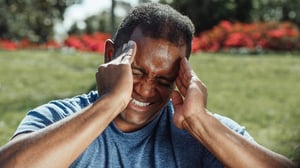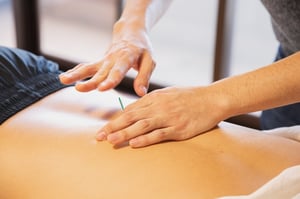Dehydration occurs when our bodies lose more fluids than we take in. It is a common condition that...
Migraines: Prevent, Alleviate, and Live Your Life
According to the American Migraine Foundation, over 4 million adults suffer from chronic migraines. Migraines are defined as severe throbbing pain, typically on one side or area of the brain, with additional symptoms such as sensitivity to light and sound. However, this description seems to only scratch the surface of something that can be so debilitating.
Migraines aren't just painful; they're also dangerous, as they cause visual impairment, muscle weakness, and fainting. Dealing with migraines can be an uphill battle, especially for older adults, but that doesn't mean that they're impossible to overcome. Conquering your migraines will become simple if you follow the steps listed below.
How to Prevent Migraines
1. Avoid Headache and Migraine Triggers.
 Triggers for migraine headaches range from genetics to environmental factors. Common migraine triggers include hormone changes, chemical imbalances, emotional stress, medications, low blood sugar, bright lights, loud sounds, physical strain, too much caffeine or alcohol, and food intolerances. To lessen your migraines, you must figure out what your triggers are and avoid them at all costs. Finding your headache triggers might sound a little tricky, but it's crucial to finding relief from your migraines.
Triggers for migraine headaches range from genetics to environmental factors. Common migraine triggers include hormone changes, chemical imbalances, emotional stress, medications, low blood sugar, bright lights, loud sounds, physical strain, too much caffeine or alcohol, and food intolerances. To lessen your migraines, you must figure out what your triggers are and avoid them at all costs. Finding your headache triggers might sound a little tricky, but it's crucial to finding relief from your migraines.
2. Make Lifestyle Changes
As we explained above, your health directly impacts your migraine symptoms. If your body isn't being cared for, it can result in painful headaches. To make sure your body is in tip-top shape, make a few lifestyle changes. Migraines can be caused by lack of sleep, so always make sure to get eight to nine hours of rest. Low blood sugar is another cause of migraines, so it's crucial to keep a regular eating schedule and never skip meals.
3. Try Alternative Therapy
 When there is no underlying cause for migraines, there are medical treatments to treat the symptoms. There are injections designed to treat both migraines and cluster headaches. However, if you're not interested in mainstream medical treatment, there are many other forms of alternative therapy.
When there is no underlying cause for migraines, there are medical treatments to treat the symptoms. There are injections designed to treat both migraines and cluster headaches. However, if you're not interested in mainstream medical treatment, there are many other forms of alternative therapy.
For example, many people find significant relief in acupuncture. Head, neck, and back massages are known to ease tension within the temples. Chiropractors use spinal manipulation to alleviate pressure on the nerves, which might be causing the headaches in the first place.
Tips to Ease Migraine Pain
Migraines pop up at the worst times, even if you've been trying to treat them with lifestyle changes and alternative therapy. That's why it's important to know how to ease the pain of a migraine when it's in full force. While there's always the option of taking over-the-counter or prescribed pain relievers, we've listed a few drug-free ways to ease migraine pain.
-
Dim the Lights and Lie Down in a Cool Room
Nothing is worse for migraines than bright lights and warm temperatures. The best way to ease the throbbing in your temples is to stay in a dim, cool room. If you have the opportunity, lie down, prop your head on a pillow, and close your eyes. Make sure the room is away from any loud and distracting sounds that will trigger migraine symptoms.
-
Keep Your Head Still
An excellent trick to reducing migraine pain is to keep your head perfectly still. As stated above, we recommended that you lay your head on a pillow and close your eyes. When you are settled and lying comfortably, try your hardest not to move your head. Too much movement can cause you to feel lightheaded and dizzy, therefore worsening your discomfort. To keep your mind off of the pain, draw your attention to your breathing patterns.
-
Try a Cold or Hot Compress
A great way to relieve your headache is to apply temperature changes by using a compress. Depending on your preferences, placing a cold or hot compress on your temples will relax your muscles and release tension. While this might not completely get rid of the migraine, it will provide a little relief.
-
Stay Hydrated
.jpg?width=300&name=pexels-anna-shvets-5067694%20(1).jpg) Dehydration headaches and migraines can be very similar, as they both can be felt behind the eyes. To ensure that you're experiencing a migraine and not a dehydration headache, drink some water to stay properly hydrated. Even if this doesn't cure the headache, staying hydrated will keep other symptoms like nausea and lightheadedness at bay.
Dehydration headaches and migraines can be very similar, as they both can be felt behind the eyes. To ensure that you're experiencing a migraine and not a dehydration headache, drink some water to stay properly hydrated. Even if this doesn't cure the headache, staying hydrated will keep other symptoms like nausea and lightheadedness at bay. -
Try Caffeine
While caffeine can be a headache trigger for some people, others find migraine relief by ingesting a small amount of caffeine. The next time you experience a migraine, try taking a sip out of a tea, soda, or coffee. However, always be careful with this method because too much caffeine could make your headache worse.
We all know that migraines can be painful and debilitating, but you don't have to let them control your life. With the correct information, the right tools, and a few minor changes, you can effectively lessen your headache symptoms and live a fuller life. All it takes is a little self-understanding and some healthy lifestyle choices, and any older adult can find relief from migraines.
Let us know in the comments below - How do you ease your migraine pain?






